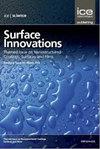约翰逊量块的摩擦和附着力
IF 3.5
4区 材料科学
Q3 CHEMISTRY, PHYSICAL
引用次数: 0
摘要
约翰逊量块(“Jo块”)由钢制成,用于精确测量长度。它们的表面非常光滑,两个块可以相互粘附,但只有在滑动(拧干)之后才会发生强粘附。文献中提出了各种各样的假设来解释块中的拧干和粘附机制,包括分子间力、油表面张力和空气压力的作用。我们研究了两个Jo块之间的摩擦滑动,以深入了解拧干的机制。结果表明,摩擦力随滑动距离的增加而增加,这与挤压作用对钢表面氧化膜的去除是一致的。这可能是Jo块粘附的主要机制。本文章由计算机程序翻译,如有差异,请以英文原文为准。
Friction and adhesion of Johansson gauge blocks
Johansson gauge blocks (“Jo blocks”) are made of steel and used for precision length measurement. Their surface is very smooth, and two blocks can adhere to each other, however, the strong adhesion occurs only after the sliding (wringing). Various hypotheses explaining wringing and adhesion mechanisms in the blocks have been suggested in the literature, including the role of intermolecular forces, oil surface tension, and air pressure. We study the frictional sliding of two Jo blocks against each other to obtain insights into the mechanisms of wringing. The results show an increase in the friction force with the sliding distance, which is consistent with the removal of the oxide film from the steel surface by wringing. This is likely the dominant mechanism of Jo block adhesion.
求助全文
通过发布文献求助,成功后即可免费获取论文全文。
去求助
来源期刊

Surface Innovations
CHEMISTRY, PHYSICALMATERIALS SCIENCE, COAT-MATERIALS SCIENCE, COATINGS & FILMS
CiteScore
5.80
自引率
22.90%
发文量
66
期刊介绍:
The material innovations on surfaces, combined with understanding and manipulation of physics and chemistry of functional surfaces and coatings, have exploded in the past decade at an incredibly rapid pace.
Superhydrophobicity, superhydrophlicity, self-cleaning, self-healing, anti-fouling, anti-bacterial, etc., have become important fundamental topics of surface science research community driven by curiosity of physics, chemistry, and biology of interaction phenomenon at surfaces and their enormous potential in practical applications. Materials having controlled-functionality surfaces and coatings are important to the manufacturing of new products for environmental control, liquid manipulation, nanotechnological advances, biomedical engineering, pharmacy, biotechnology, and many others, and are part of the most promising technological innovations of the twenty-first century.
 求助内容:
求助内容: 应助结果提醒方式:
应助结果提醒方式:


